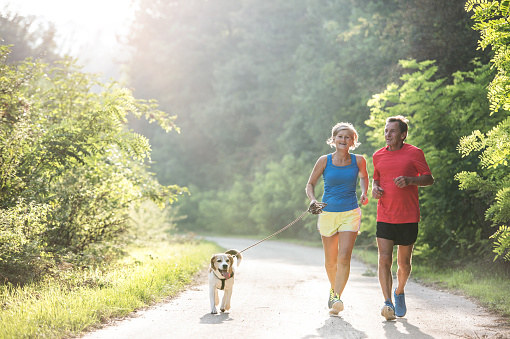Running with Your Dog

As spring arrives many of us get the urge to start or restart running again. Like us, dogs also need daily exercise to maintain good fitness and mental health. After all, a tired dog is a good dog. It is estimated that over half of the dogs in America are overweight or obese. Running or speed walking with your dog is a good way for both of you to maintain a healthy lifestyle, keep off unwanted pounds, enjoy the sunshine and spend some quality time together. Should you decide to run with your dog, here are some suggestions to consider.
Health and Stamina
Prior running with your dog it is important to consider his or her ability to handle physical exertion. Overweight or obese dogs may need to lose some weight first and may need to start out at a walking pace for a month or two. Dogs with hip dysplasia, arthritis or other medical conditions are not well-suited to running. Brachycephalic (short snout) breeds can have small nostrils or other upper airway abnormalities that make running for an extended period of time dangerous. If you are in doubt, ask your veterinarian about your dog’s ability to begin a running program.
New Leash on Life
Running with your dog can open up a whole new world of exploration and excitement, but it is important to be safe. A collar or harness with proper identification is a must. Consider permanent identification, such as a microchip, so your dog can be found and returned should he or she get lost. Your dog should also be well behaved on a leash and leashed at all times. Make certain he is well trained to the leash so he does not stop to sniff or mark every tree. “Leave it” should be a command in your dog’s repertoire so he does not pick up tempting items such as trash and road kill. “Sit” and “Stay” are also useful commands for traffic crossings.
Water
When your dog is running, he is working just as hard as you. Be sure to carry extra water and a collapsible water bowl or a water bottle with a special spout for dogs so he can stay hydrated along the way. Since dogs cannot tell you when they are thirsty, a good rule of thumb is to give your dog a drink every time you take a drink.
Don’t forget the “Running Shoes”
Some dogs have naturally sensitive pads or get sore pads from running on a hard surface. Consider using a conditioning wax on their pads or using booties. If using booties, remember it may take some time for your dog to become accustomed to them. Also, be sure to use a bootie with a tough bottom so it will stand up to heavy use. For most dogs foot protection is usually not necessary. On sunny days, remember to check the temperature of the road. Black top and sidewalks can get hot enough to burn your dog’s pads. Check the temperature using the 5 second rule. Lay the back of your hand on the black top or sidewalk. If you cannot hold it there for 5 seconds, then it is too hot for your dog’s feet.
Remember the Warm Up
Before running, your dog will need a warm up, just like you do, to prevent injuries. Start with a few minutes of walking, slow jogging or ball play to warm up and to stretch muscles and ligaments.
Dog Days of Summer
Dogs overheat more easily than we do because of their hair coat and because they do not sweat. When it is warm and humid, avoid running in the midday heat or avoid running altogether. In the summer, consider running on shaded trails rather than the road. The softer ground will also be better for your dog’s feet and joints. Watch for signs of heat stroke such as drooling, lethargy, weakness, dark red gums, vomiting or bloody diarrhea. If your dog is showing signs of heat stroke, find some shade, give him small amounts of water frequently, pour water on his head and body, and call your veterinarian.
General Guidelines
For most dogs, 2-3 miles is a good goal to work up to. Some athletic dogs with training over time may be able to go longer distances. When you stop for a break, if takes more than 10 minutes for your dog to stop panting, then you need to shorten the distance until he or she is in better condition. Spring and fall are the best times to run with your dog.
Have Fun Running
Once your dog becomes accustomed to running with you, both of you will always have a willing running companion. Make sure your dog seems happy running. If he gets excited and barks when you get ready to run and grab the leash, it is a good sign he enjoys running with you. If he seems stiff or uncomfortable, consider leaving him home for a day or two. If he remains stiff and uncomfortable, seek veterinary care.
